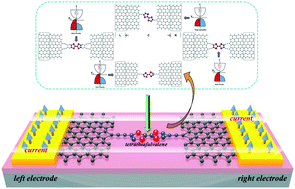A molecular device providing a remarkable spin filtering effect due to the central molecular stretch caused by lateral zigzag graphene nanoribbon electrodes†
Abstract
Through the density functional theory, we studied molecular devices composed of single tetrathiafulvalene (TTF) molecules connected with zigzag graphene nanoribbon electrodes by four different junctions. Interestingly, some devices have exhibited half-metallic behavior and can bring out a perfect spin filtering effect and remarkable negative differential resistance behavior. The current–voltage characteristics show that these four devices possess different spin current values. We found that all the TTF molecules were stretched due to interactions with the electrodes in the four devices. This leads to the Fermi levels of the three devices being down-shifted to the valence band; therefore, these devices exhibit half-metallic properties. The underlying mechanisms of the different spin current values are attributed to the different electron transmission pathways (via chemical bonds or through hopping between atoms). These results suggest that the device properties and conductance are controlled by different junctions. Our work predicts an effective way for designing high-performance spin-injected molecular devices.



 Please wait while we load your content...
Please wait while we load your content...